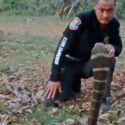It’s a cloudy afternoon, perfect to relax, watching the rain from the couch. But wait. What’s that in the sky? Is that a tornado? Oh, yes, but this is a Mega Tornado and you’re right on its path. What can you do? Where should you hide? Don’t worry.
Tornadoes can form almost everywhere in the world. They occur when warm and humid air, near the Earth’s surface, gets trapped underneath a layer of cold and dry air. The central part of the United States, called Tornado Alley, is the most likely area in the world for tornadoes to form. The cold air from the North Pole meets the warm, moist, tropical air from the Gulf of Mexico, and forms these scary giants.
Tornadoes are measured using the Enhanced Fujita Scale. It rates tornados from EF-0 to EF-5, based on the damage it caused. EF0 tornados can have gust of wind of 100 km/h (65 mph), and the incredible EF-5 twisters have wind gusts over 322 km/h (200 mph). But the strongest tornado ever recorded hit Oklahoma City on May 3, 1999. Its wind speed reached 511 km/h (318 mph), caused $1 billion dollars in damage and killed 36 people. But the one that’s coming for you is going to be even worse.
How can you tell if a tornado’s forming? How much time do you have to get to safety? If you have a choice, where’s the best place to take shelter?
Step 1: Look at the sky
Every second can mean the difference between life and death, so learn to identify the early signs of a tornado. During the storm, look for green or yellow clouds. The wind sound like loud rumbling and whistling. And if you see a big funnel cloud forming, it’s time to run, my friend. On average, the National Weather Service can alert a town 18 minutes before the tornado hits. This may be not enough for you to find proper shelter, so hurry up.
Step 2: Go underground
The best place to shelter is underground. A basement with a reinforced entry would be your life-saving den. If you aren’t near a basement, look for a thick concrete or heavy buildings. And don’t shelter under bridges or overpasses. A mega tornado could be strong enough to take them down, and bury you under debris.
Step 3: Let go of the wheel
If you’re in a car, and a tornado forms around you, look for shelter immediately. Trying to drive away could make you more vulnerable. Tornadoes can easily lift up a car and drop it. In 1966, a tornado reportedly sucked up a car. Inside, a woman had been driving with her 2-year-old daughter. The car was lifted 20 m (65 ft) from the ground, and carried to the top of a building. Surprisingly, both the woman and her daughter survived. But not everyone is that lucky. According to the National Weather Service, 7% of the people killed by tornadoes were in vehicles when the storm hit.
Step 4: Don’t take it easy
Even if you’re tens of kilometers from the tornado, you can’t take it easy. Tornados are extremely unpredictable. They can change direction, speed, and width every second. And they can stay on the ground for hours. The Tri-State Tornado of 1925 stayed on the ground for three hours, traveled about 350 km (219 mi) across Illinois, Missouri, and Indiana, and killed near 700 people. So, stay alert.
Step 5: Have a plan
Tornados can form in almost anywhere in the world, but some places get hit a lot more often than others. Tornado Alley includes some regions of Texas, Iowa, Kansas, Nebraska, and Ohio. Bangladesh is another critical spot. Six of the 10 all-time deadliest tornados have happened in this Asian country. Actually, the deadliest tornado ever took place here in 1989. It killed about 1,300 people and destroyed two towns.
If you live in any of these dangerous areas, be prepared. Identify where there are shelters underground, and make emergency plans with your family. Include the best routes to get there when necessary. Always have emergency backpacks with your important documents, food, water and medicines.
Step 6: Be patient
If you’re in a shelter and it seems the storm is over, don’t rush out immediately. It could take hours before it’s safe to leave. There could be mini-tornados rotating around the main one. And they can kill you as well. Or the tornado could return. You need to stay informed, but your phone may not work. So keep a radio with fresh batteries handy. Then you’ll be able to hear if it’s safe to come out.
Sources
- “Tornado-Proofing Your Mobile Home.“. Bosch, Torie. 2005. Slate Magazine.
- “Where Tornadoes Happen | UCAR Center For Science Education“. 2020. Scied.Ucar.Edu.
- “Can You Really Outrun A Tornado?“.Garden, Home, HowStuffWorks, Science, Nature, and Disasters. 2014. Howstuffworks.
- “The Enhanced Fujita Scale (EF Scale)“. 2020. Weather.Gov. https://www.weather.gov/oun/efscale.
- “Tornadoes, Explained“. 2019. National Geographic.
- “Before, During, And After A Tornado“. 2020. Economical Insurance.
- “Frequently Asked Questions About The May 3, 1999 Bridge Creek/OKC Area Tornado“. 2020. Weather.Gov.



























